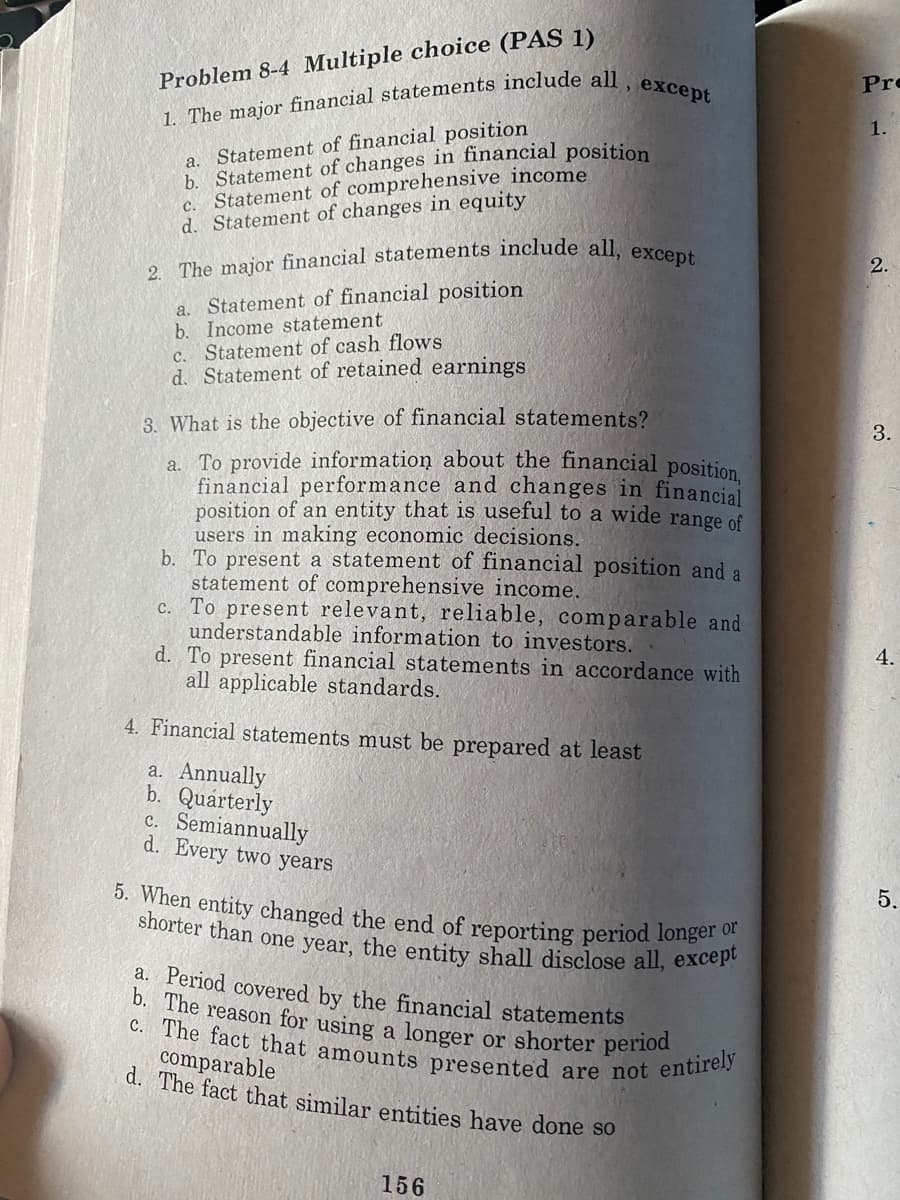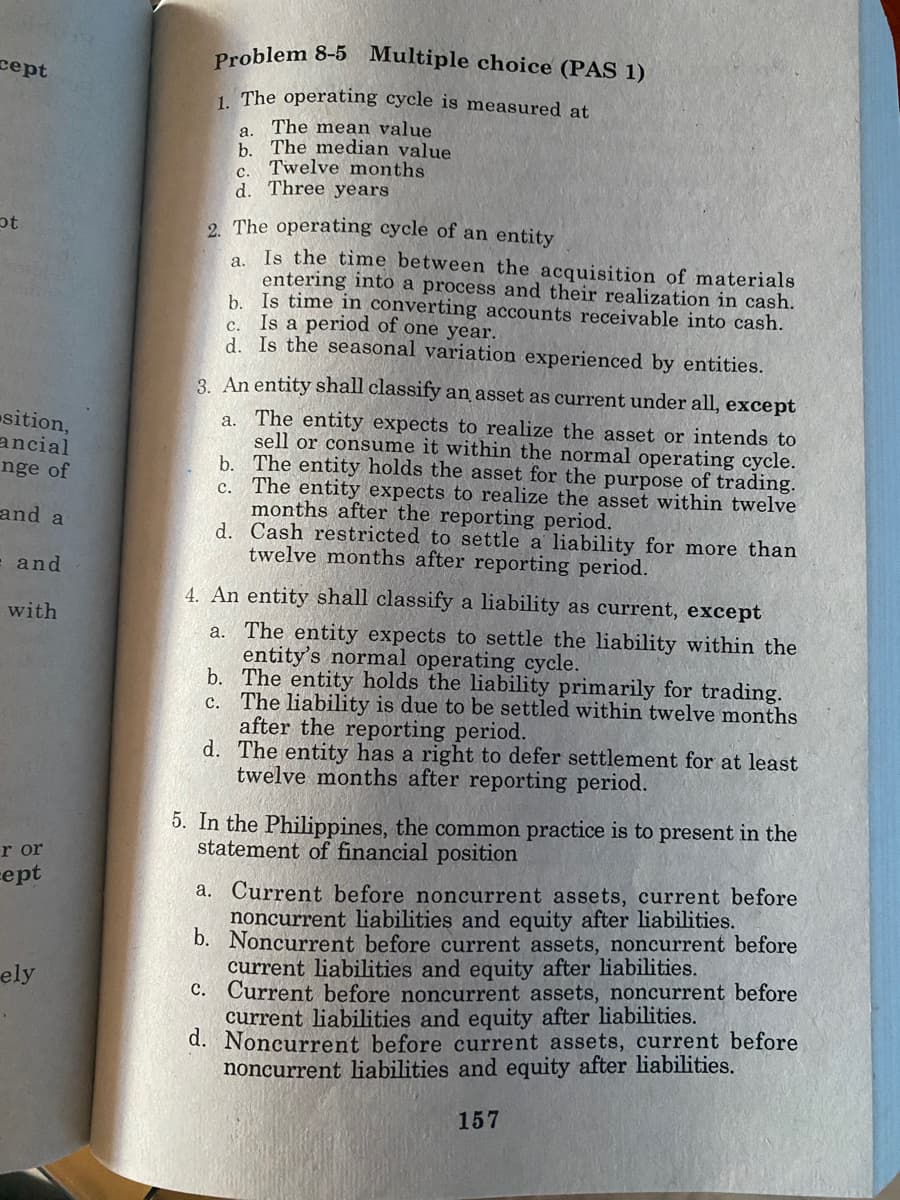Problem 8-4 Multiple 1. The major financial statements include all, except a. Statement of financial position b. Statement of changes in financial position c. Statement of comprehensive income d Statement of changes in equity
Problem 8-4 Multiple 1. The major financial statements include all, except a. Statement of financial position b. Statement of changes in financial position c. Statement of comprehensive income d Statement of changes in equity
Cornerstones of Financial Accounting
4th Edition
ISBN:9781337690881
Author:Jay Rich, Jeff Jones
Publisher:Jay Rich, Jeff Jones
Chapter1: Accounting And The Financial Statements
Section: Chapter Questions
Problem 16CE: Cornerstone Exercise 1-16 Financial Statements Listed below are elements of the financial...
Related questions
Question
Kindly answer the following items in problems 8-4 and 8-5.

Transcribed Image Text:Problem 8-4 Multiple choice (PAS 1)
1. The major financial statements include all
a. Statement of financial position
b. Statement of changes in financial position
c. Statement of comprehensive income
d. Statement of changes in equity
2. The major financial statements include all, except
a. Statement of financial position
b. Income statement
c. Statement of cash flows
d. Statement of retained earnings
, except
3. What is the objective of financial statements?
a. To provide information about the financial position,
financial performance and changes in financial
position of an entity that is useful to a wide range of
users in making economic decisions.
b. To present a statement of financial position and a
statement of comprehensive income.
c. To present relevant, reliable, comparable and
understandable information to investors.
d. To present financial statements in accordance with
all applicable standards.
4. Financial statements must be prepared at least
a. Annually
b. Quarterly
c. Semiannually
d. Every two years
5. When entity changed the end of reporting period longer or
shorter than one year, the entity shall disclose all, except
a. Period covered by the financial statements
b. The reason for using a longer or shorter period
c. The fact that amounts presented are not entirely
comparable
d. The fact that similar entities have done so
156
Pre
1.
2.
3.
4.
5.

Transcribed Image Text:cept
ot
sition,
ancial
nge of
and a
= and
with
r or
cept
ely
.
Problem 8-5 Multiple choice (PAS 1)
1. The operating cycle is measured at
The mean value
a.
b. The median value
Twelve months
C.
d. Three years
2. The operating cycle of an entity
Is the time between the acquisition of materials
entering into a process and their realization in cash.
b. Is time in converting accounts receivable into cash.
Is a period of one year.
C.
d. Is the seasonal variation experienced by entities.
a.
3. An entity shall classify an asset as current under all, except
a. The entity expects to realize the asset or intends to
sell or consume it within the normal operating cycle.
b. The entity holds the asset for the purpose of trading.
c. The entity expects to realize the asset within twelve
months after the reporting period.
d.
Cash restricted to settle a liability for more than
twelve months after reporting period.
4. An entity shall classify a liability as current, except
a. The entity expects to settle the liability within the
entity's normal operating cycle.
b. The entity holds the liability primarily for trading.
The liability is due to be settled within twelve months
after the reporting period.
c.
d.
The entity has a right to defer settlement for at least
twelve months after reporting period.
5. In the Philippines, the common practice is to present in the
statement of financial position
a. Current before noncurrent assets, current before
noncurrent liabilities and equity after liabilities.
b. Noncurrent before current assets, noncurrent before
current liabilities and equity after liabilities.
c. Current before noncurrent assets, noncurrent before
current liabilities and equity after liabilities.
d. Noncurrent before current assets, current before
noncurrent liabilities and equity after liabilities.
157
Expert Solution
This question has been solved!
Explore an expertly crafted, step-by-step solution for a thorough understanding of key concepts.
Step by step
Solved in 2 steps

Knowledge Booster
Learn more about
Need a deep-dive on the concept behind this application? Look no further. Learn more about this topic, accounting and related others by exploring similar questions and additional content below.Recommended textbooks for you

Cornerstones of Financial Accounting
Accounting
ISBN:
9781337690881
Author:
Jay Rich, Jeff Jones
Publisher:
Cengage Learning

Cornerstones of Financial Accounting
Accounting
ISBN:
9781337690881
Author:
Jay Rich, Jeff Jones
Publisher:
Cengage Learning